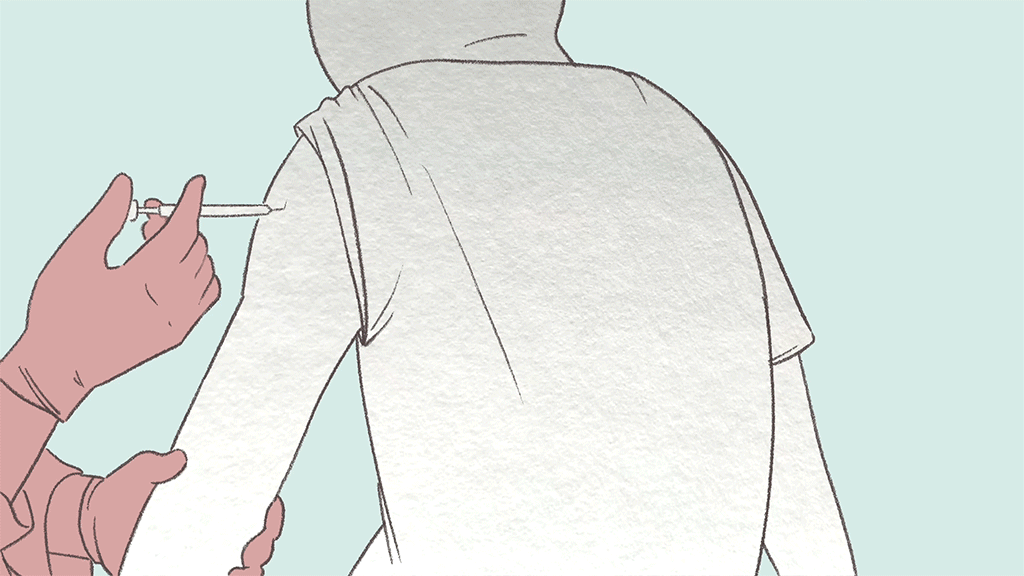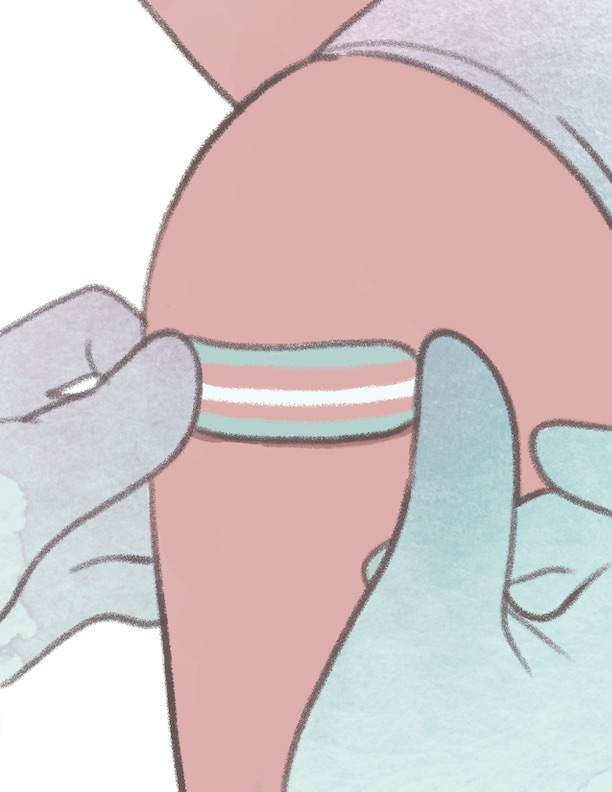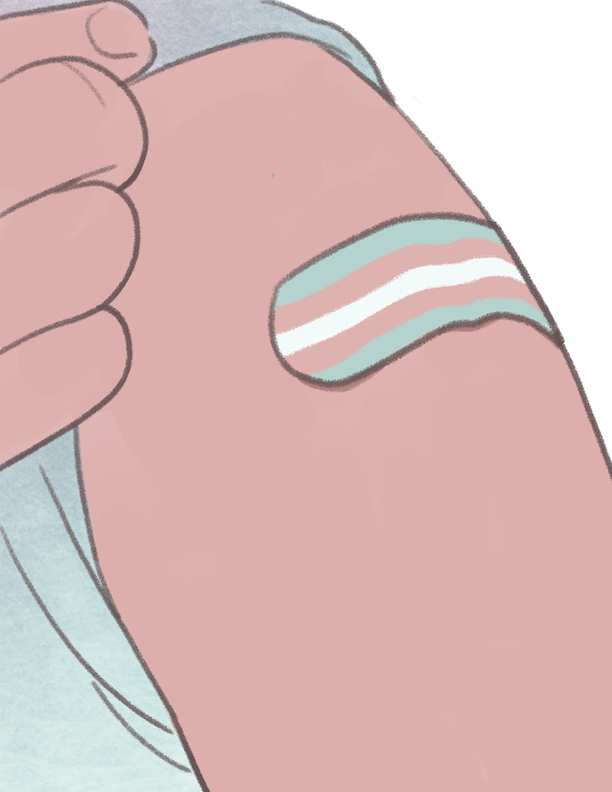Strengthening transgender care through data
Families across the country don’t understand the effect of early treatment on transgender kids. Helen Santoro explores how researchers are working to change that. Illustrations by Emily Matteson.

Illustration: Emily Matteson
Four years ago, Kimberly Richman’s 6-year-old daughter became engrossed in the book “I Am Jazz.” Based on the real-life story of Jazz Jennings, a trans activist who started transitioning from male to female at 11 years old, this book was the beginning of an unexpected journey for the Richman family.
Richman’s daughter had a lot of questions. She asked, “‘Jazz’s family won’t let her wear a dress, even though she identifies as female. Would you do this to me?’” Richman recalled.
Last summer, at nine years old, Jack — that is not his real name — announced that he is not a girl. He wanted to be referred to using male pronouns moving forward.
Jack’s mother considers him lucky to have come out during a time where attitudes towards transgender rights are changing among medical professionals and the general public. But there is still surprisingly little data on how transgender medical treatments effect children’s health as adults.
Researchers at UC San Francisco’s Child and Adolescent Gender Clinic, based out of Benioff Children’s Hospital, are working to change this. Since 2015, they have been conducting a study in collaboration with other hospitals that aims to recruit 280 patients ages 8 to 18 to understand the long-term effects of transgender treatments. These treatments include puberty blockers, which press pause on puberty, and “gender-affirming” hormones, such as testosterone and estrogen, which help patients develop sex characteristics more aligned with their internal gender identity.
Patients across the country are being monitored extensively during the first two years of their treatments as part of the trial. Doctors are examining patients’ mental health and bone development, which changes based on a child’s pubertal status.
Today, roughly 150,000 kids in the U.S. ages 13 to 17 identify as transgender, making up 0.7 percent of that age group, according to the Williams Institute, a think tank at UCLA School of Law. Under the current federal administration, the future of these individuals’ rights is unclear.
Researchers in the Netherlands previously tracked transgender patients 12 and older. But the UCSF study is the first to include children under 12 and thoroughly track not only transgender patients’ psychological health, but their physical health over time.
“Parents will say to us, ‘What do you really know about the long-term effects of puberty blockers? Who has really studied the children for 20 years?’” said Diane Ehrensaft, a clinical psychologist and the UCSF clinic’s mental health director. “And we say, ‘That’s what we plan to do.’”
Creating a safe space for transgender kids
The UCSF clinic got its start thanks to researchers like Ehrensaft, who says that gender has always been at the heart of her work. But it wasn’t until she became a mother that the issues surrounding trans and gender-expansive children entered her personal life.
Transgender individuals are people whose internal gender identity does not align with their biological sex. Gender-expansive individuals, on the other hand, do not conform to either the male or female gender.
“I had a gender-expansive child,” she said. “I had a boy who just loved to share tutus with his sister. And this was in the 1970s, so I learned a lot by doing.”
Ehrensaft first met pediatric endocrinologist Dr. Stephen Rosenthal, the UCSF clinic’s medical director and a principal investigator on the study about a decade ago. They sat down to discuss developing an interdisciplinary center to help transgender youth. With the support of a group of medical professionals, they opened the doors to the UCSF clinic in May of 2012.
The clinic practices what is called the “gender affirmative model,” which allows both transgender and gender-expansive patients to express their gender identity regardless of their age.
“We make it very clear that the first priority is to listen to the youth and learn from them what they would like to tell us about their gender,” Ehrensaft said. One of their goals is to discover each patient’s “authentic gender,” which she said, “lies between your ears, not between your legs.”
Not all patients go on to transition. But for those who do, patients in the early stages of puberty start with puberty blockers, otherwise called gonadotropin-releasing hormone, or GnRH, agonists.
GnRH agonists suppress the release of gonadotropins — a group of hormones that stimulate the production of sex hormones from the testis or ovaries. Without the release of gonadotropins, a child cannot produce estrogen, testosterone or progesterone, pausing his or her pubertal growth. This gives transgender kids more time to explore their gender identity before they develop sex characteristics such as breasts and pubic hair.
Transgender children are at a very high risk of depression, substance abuse and suicide — and psychologists have found that these issues only increase once the child goes through puberty. With the help of puberty blockers, the clinic hopes to mitigate these problems.
Older patients who have already undergone puberty can start taking either testosterone or estrogen to develop the physical characteristics of their authentic genders.
All of these patients then go on to receive follow-up visits to evaluate the progress of their mental and physical health. This includes providing the family with mental health professionals to help them during the transition process and finding the correct treatment dosage. This type of medical approach made the UCSF clinic the obvious place to launch a study into the long-term effects of these treatments on kids.
A trying road
But clinics like this one are a relatively new phenomenon.
For most of our history, safe places where transgender individuals could receive medical care were practically nonexistent.
In 1918, German physician Magnus Hirschfeld coined the term “transvestite”. He defined it as someone who habitually expresses him or herself in ways traditionally associated with the opposite sex. At his Institute for Sexual Science in Berlin, Hirschfeld was one of the first doctors to offer sex-changing treatments — a practice that eventually led the Nazis to destroy his institution in 1933.
With such hostility and controversy surrounding transgender care, it wasn’t until 1966 that German endocrinologist Harry Benjamin published his influential book, The Transsexual Phenomenon. He asserted that transsexual adults and children benefit greatly from gender-affirming treatments, paving the road for modern-day transgender healthcare.
In 1979, Benjamin founded the Harry Benjamin International Gender Dysphoria Association. Now called the World Professional Association for Transgender Health, or WPATH, this nonprofit organization is made up of a wide range of professionals dedicated to creating evidence-based care for transgender and gender-expansive individuals.
Even with the help of WPATH, many transgender individuals were left with little to no doctors who had the knowledge or willingness to provide them with proper care.
“There was so much strong gender policing growing up,” said clinical psychologist Erica Anderson, who transitioned from male to female. “If you were interested in the things that the other sex was interested in as a boy, you were a sissy. If you were a girl, you were a tomboy. And I was never a sissy.”
Over two decades after WPATH’s inception, Anderson walked into an endocrinologist’s office in Bryn Mawr, Pennsylvania. She was 50 years old and asked the doctor for hormones to begin transitioning from male to female.
The physician and offered no help. She said, ‘I don’t do that,’” recalled Anderson, who now works with transgender patients at the UCSF clinic. “I left the office feeling like a leper.”
The physician and offered no help. She said, ‘I don’t do that,’” recalled Anderson, who now works with transgender patients at the UCSF clinic. “I left the office feeling like a leper.”
During this time, researchers in the Netherlands were working to improve the quality of transgender healthcare. In a 2014 publication in the journal Pediatrics, clinical psychologist Peggy Cohen-Kettenis and psychiatrist Annelou de Vries from the Center for Expertise on Gender Dysphoria in Amsterdam presented the first-ever data on the long-term psychological outcomes from the “Dutch model” for transgender care.
In the Dutch model, the use of either puberty blockers or gender-affirming hormones is based on the patient’s age. Children can only take puberty blockers if they are 12 or older, and adolescents need to be at least 16 to start taking gender-affirming hormones. Gender reassignment surgery, which includes procedures such as breast removal and the construction of a vaginal cavity, can be performed at 18 or older.
Cohen-Kettenis and de Vries examined 55 transgender youth when they first took puberty blockers at around 13 years old, when they started gender affirming hormones at around 16 years old and one year after gender reassignment surgery at around 20 years old. Patients completed surveys covering factors including body image, depression and quality of life.
They found a significant decrease in gender dysphoria — patient distress surrounding their physical bodies and internal gender identities.This was the first study to show such positive outcomes from these treatments, making it a groundbreaking discovery in the field of transgender research.
In contrast to the Dutch model, the gender affirmative model at UCSF bases the use of puberty blockers and gender-affirming hormones on the patient’s pubertal stage rather than age. Known as the Tanner stages, these levels define patients’ sexual maturity by their physical changes, such as pubic hair growth and the beginning of menstruation.
Because children experience these physical changes at a range of ages, patients have far more flexibility as to when they can start puberty blockers or gender-affirming hormones. Patients at the very beginning of puberty, which can occur as young as eight years old, can start puberty blockers. And patients in the late stages of puberty, which can occur as young as 12 years old, can start hormones.
Better data, better understanding
Jacob Bilstein sports short, dirty-blond hair and black, thick-rimmed glasses. When asked where he sees himself in 10 years, he answers with a self-assurance far beyond that of most 16-year-olds.
“I want to work in a psychiatric hospital,” he said. “I want to be successful.”
After going through puberty as a girl, Jacob was sure that he was in the wrong body. He told his mother, Jennifer, who remembers struggling to process the information.
Luckily, the family lives just north of San Francisco in the quaint town of Ukiah. Through some online searching, they discovered the UCSF clinic and arrived for their first visit when Jacob was nearing 14 years old. Once he met with his care team, Jacob, who is not enrolled in the UCSF study, finally had a plan of action for his transition process. Although he is not yet on testosterone, “going to the clinic and actually taking a first step forward was really exciting,” he expressed.
Patients at the clinic who are about to start either puberty blockers or gender-affirming hormones have the opportunity to enroll in a long-term study. They complete a list of surveys and an interview by a medical professional every six months for two years. Additionally, patients have follow-up appointments with their doctors to track their physical transitions.
As in the Dutch study, Ehrensaft is keen on examining the patients’ mental health, including their anxiety, depression and gender distress. However, she considers the study at UCSF to be far more comprehensive. “We have widened the lens on what we are looking at in terms of gender health,” Ehrensaft said.
For instance, along with a wider array of psychological and social assessments, the UCSF team is tracking patients’ bone health. For young patients on puberty blockers, their hormone levels are reduced back to pre-pubertal levels, thus suppressing the calcium absorption that normally begins strengthening their bones during puberty. Rosenthal is interested in seeing how this impacts patients’ bone health over time.
“One of the things that happen during puberty besides things you see externally, like breast and penile development, is an uptake of calcium into the bones,” Rosenthal explains. “And this is largely dependent on the presence of either testosterone or estrogen.”
Along with following a significantly larger number of patients than the Dutch study, this investigation is the first to track transgender youth “receiving medical interventions based on stages, not ages,” said Ehrensaft.
Jacob’s mother, Jennifer, believes this study will provide essential information for parents of transgender kids.
This new understanding of the long-term effects of puberty blockers and hormones will “help people to look at things from a different perspective instead of utilizing the views that everybody grew up with 50 years ago,” she said.
Richman, whose child became obsessed with the book “I Am Jazz,” thinks the gender affirmative care offered at the clinic is literally life-changing. Jack is currently a patient at the UCSF clinic and on the path to receiving puberty blockers.
Richman believes that any physical side effects from puberty blockers are not nearly as important as the relief they provide to trans kids suffering from depression or suicidality.
“We’re bypassing a lot of troubles by allowing him to start this transition at this age,” Richman said. “It’s so much more proactive and healthy and safe than waiting until they’re adults and have a breaking point.”
Some controversy
But even as families praise the UCSF study and the clinic’s gender-affirmative approach, some medical professionals argue these treatments are being used without any evidence to support their safety or efficacy.
In 2017, an article in The New Atlantis, a conservative journal, argued that children are not capable of understanding what it means to be a man or a woman.
Written by epidemiologists Paul Hruz and Lawrence Mayer and psychiatrist Paul McHugh, the article asserts that puberty blockers are both unnecessary and harmful.
As the former chief of psychiatry at Johns Hopkins Hospital, McHugh has worked with transgender patients and families since the 1970s. His philosophy is to encourage patients to postpone any medical decision until the team has ruled out any other psychological factors that could be influencing the patient’s desire to transition.
“There is an epidemic, particularly among male-to-female transgender patients,” he said. That worries me, and I think that should worry everyone in America.”
Dr. Johanna Olson-Kennedy, the medical director of the Center for Transyouth Health and Development at the Children’s Hospital Los Angeles and principal investigator on the UCSF study, disagrees.
“I have a fundamental problem with the way in that the autonomy is stripped from trans people,” she said. “It’s frustrating to me the idea that someone else could know your gender better than you do.”
A forward-thinking approach
The UCSF clinic’s study grant runs out in 2020, but the team hopes to continue tracking the patients as they grow into adulthood.
 “I’m thrilled to see that this project has been funded by the NIH,” said epidemiologist Kerith Conron, the research director of the William’s Institute whose work focuses on reducing health inequalities that impact the LGBTQ population. Conron is not involved in the study. “Medical doctors are not sure when they should begin hormone treatment with trans youth. There are a lot of unanswered questions.”
“I’m thrilled to see that this project has been funded by the NIH,” said epidemiologist Kerith Conron, the research director of the William’s Institute whose work focuses on reducing health inequalities that impact the LGBTQ population. Conron is not involved in the study. “Medical doctors are not sure when they should begin hormone treatment with trans youth. There are a lot of unanswered questions.”
Researchers plan to submit the first of their results to journals within the next year. They are also presenting their initial psychological findings at the upcoming American Psychological Association meeting in Chicago this August.
In the meantime, Anderson and counselor Ben Geilhufe are teaching clinics in San Francisco County how to properly use the gender affirmative model.
“A transition path isn’t linear. You don’t start and then finish,” said Geilhufe, himself a trans man. “However, many medical professionals will ask many of my clients, ‘Hey, are you done? Did you finish?’”
The clinic is aware that there are still many challenges for transgender youth that lie ahead. This includes an ongoing attempt by the Trump administration to redefine the word “gender” as a biological condition determined by genitalia at birth, which could strip transgender people of significant medical rights.
The research team believes the only way to move forward is through collecting more data and sharing their knowledge on transgender youth with the public.
“What I’m hoping is that people will see that we can accumulate objective information,” said Rosenthal. “We need the best quality data, and I would like to see that happen through our participation. I just want to see care be based on evidence.”
A version of this piece was originally published by the San Jose Mercury News.
© 2019 Helen Santoro / UC Santa Cruz Science Communication Program

Helen Santoro
Author
B.A. (neuroscience) Hamilton College
Internships: Stanford University School of Medicine, San Jose Mercury News, Science Magazine, High Country News
My beginning was peculiar: before I opened my eyes, I had already been inside a brain imaging machine. At one day old, I was diagnosed with a prenatal stroke, thus beginning my relationship with neuroscience.
Years later, doctors studied my brain’s electrical activity. As I lay on a table with electrodes glued to my scalp and cables flowing from my head like Medusa’s snakes, I watched in wonder as my brain waves crawled across a monitor. The doctors changed my diagnosis from stroke to cyst — a structural abnormality in the brain.
To understand more about this diagnosis and the brain in general, I studied neuroscience at Hamilton College and went on to spend two years working at a neuroscience research lab at Boston Children’s Hospital.
Now, I use writing as a means to illuminate the beauty of neuroscience. With pen and paper, I hope to provide readers with the same sense of wonder I felt watching my brain waves years ago.

Emily Matteson
Illustrator
B.F.A (studio practices) University of Colorado, Boulder
Internship: Studio Abachar (Aptos, California), Ink Dwell Studio (Half Moon Bay, California)
Raised on the mesas of the North Fork Valley in rural western Colorado, Emily Matteson became close with many organisms and their lessons of life. These relationships with the plants and animals of her home were what motivated her work at the University of Colorado, Boulder, where she practiced in painting, new media, video, installation, and performance. With an interest in ethnobiology and rural practices, Emily creates art to make our natural surroundings more accessible; to encourage viewers to re-evaluate their relationships with plants, animals, and environments. Using the language of her work, she will translate for the natural world and fill in the gaps between understandings.
My secret story was awful and I was sad…
A long time ago I played the cars called Hot Wheel. But I’m only man, I don’t like such gay and silly girls,
Two years later I was almost 8 years old… I was going to the bathroom, which strange I look my body came out mini stars it looked magic fantasy in the mirror.
I said, “Oh no, please I don’t want to be a girl… Stop it”
My parents don’t know that if I were a girl, it’s that I was very worried that I would never tells my parents and friends.
1 year later I was very quiet never to wear clothes as a woman.
Mysterious my mind has changed was alone, while Mom just came to my room, she calls me What happened to you?! It’s late that you have to hurry to the bathroom as soon as you get to school.
I almost finished the shower, I looked at the uniform in bed and I said I don’t want to wear the school shirt anymore. I yell: Mom, I don’t want any more shirt!
Mama gets angry and said, “Why don’t you want to put on a shirt so you don’t go to school? If you’re sick? Maybe we’re going
to consult a doctor, check your case.
A few days the doctors have already checked and also x-ray skull no accidental or injury.
At night, I did not dream, that happened my mind has forced me to wear girl’s clothes.
In the night, I did not dream, that happened my mind has forced me to dress clothes like a girl, I could not stop the mind still dreamed goes several hours and several days suffered phobia and I felt headache is that I can do nothing.
Next day follows the mind demands something to put on those clothes as a girl and I said I can’t take it anymore, I went to try my mother’s clothes because we don’t have clothes like silly girls.
I already put on my mother’s clothes and what strange mind has ended dream, I don’t know why and then I felt strange body is just love women’s clothes.
A few months later my strange mind has forced you to come uniforms are a skirt, a blouse with baby lace neck, long socks and the patent leather shoes “T” converted to me and I study the tasks of the class, things in private every day and also obligated several cute dresses, socks with ruffles, ballet sleeves… When it’s very cold, wearing school sweaters, polar shanties, shirts pajamas with lace baby neck, and also robes.
Years later I was 21 years old I never wearing bras and the corset, which happened my body naked it looks real sex girl as little girl is so weird.
My mind is back no more orders, right now I cant stop it wears cloths as woman because my body loved some cloths.
/End,,,